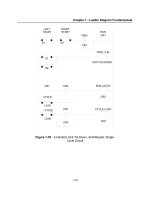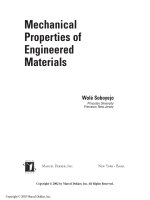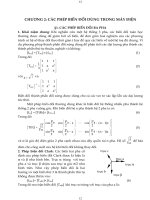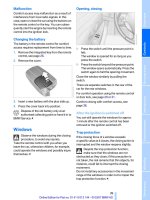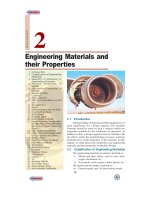Tài liệu Mechanical Properties of Engineered Materials P2 pptx
Bạn đang xem bản rút gọn của tài liệu. Xem và tải ngay bản đầy đủ của tài liệu tại đây (435.28 KB, 10 trang )
Defectsareimperfectionsinthestructure.Theymaybeone-dimensional
pointdefects(Fig.2.6),linedefects(Fig.2.7),two-dimensionalplane
defects(Fig.2.8),orthree-dimensionalvolumedefectssuchasinclusions
orporosity,Fig.1.16(d).Thedifferenttypesofdefectsaredescribedbriefly
in this section.
2.3.1 One-Dimensional Point Defects
One-dimensional point defects [Fig. 2.6) may include vacancies [Fig. 2.6(a)],
interstitials [Figs 2.6(a) and 2.6(b)], solid solution elements [Fig. 2.6(b)], and
pairs or clusters of the foregoing, Fig. 2.6(c). Pairs of ions (Frenkel defects)
or vacancies (Schottky defects) are often required to maintain charge neu-
trality, Fig. 2.6(c). Point defects can diffuse through a lattice, especially at
temperatures above approximately 0.3–0.5 of the absolute melting tempera-
ture. If the movement of point defects produces a net state change, it causes
thermally activated stress-induced deformation, such as creep. The diffusion
of point defects such as vacancies may also lead to the growth of grains in a
polycrystalline material.
2.3.2 Line Defects
Line defects consist primarily of dislocations, typically at the edges of
patches where part of a crystallographic plane has slipped by one lattice
F
IGURE
2.6 Examples of point defects: (a)] vacancy and interstitial elements;
(b) substitutional element and interstitial impurity element; (c) pairs of ions
and vacancies. [(a) and (c) are adapted from Shackleford, 1996—reprinted
with permission from Prentice-Hall; (b) is adapted from Hull and Bacon,
1984. Reprinted with permission from Pergamon Press.]
Copyright © 2003 Marcel Dekker, Inc.
spacing (Fig. 2.7). The two pure types of dislocations are edge and screw,
Figs 2.7(a) and 2.7(b). Edge dislocations have slip (Burgers) vectors perpen-
dicular to the dislocation line [Fig. 2.7a)], while screw dislocations have
translation vectors parallel to the dislocation line, Fig. 2.7(b). In general,
however, most dislocations are mixed dislocations that consist of both edge
and screw dislocation components, Fig. 2.7(c). Note that the line segments
along the curved dislocation in Fig. 2.7(c) have both edge and screw com-
ponents. However, the deflection segments are either pure edge or pure
screw at either end of the curved dislocation, Fig. 2.7(c).
F
IGURE
2.7 Examples of line defects: (a) edge dislocations; (b) screw disloca-
tions; (c) mixed dislocations. (Adapted from Hull and Bacon, 1980. Reprinted
with permission from Pergamon Press.)
Copyright © 2003 Marcel Dekker, Inc.
2.3.3 Surface Defects
Surface defects are two-dimensional planar defects (Fig. 2.8). They may be
grain boundaries, stacking faults, or twin boundaries. These are surface
boundaries across which the perfect stacking of atoms within a crystalline
lattice changes. High- or low-angle tilt or twist boundaries may involve
changes in the crystallographic orientations of adjacent grains, Figs 2.8(a)
and 2.8(b). The orientation change across the boundary may be described
using the concept of coincident site lattices. For example, a Æ ¼ 5or
F
IGURE
2.8 Examples of surface defects: (a) low-angle tilt boundary; (b) high-
angle tilt boundary; (c) S ¼ 5 boundary; (d) twin boundary; (e) intrinsic stack-
ing fault; (f) extrinsic stacking fault. (Adapted from Shackleford, 1996.
Reprinted with permission from Prentice-Hall.)
Copyright © 2003 Marcel Dekker, Inc.
Æ
À1
¼1=5boundaryisoneinwhich1in5ofthegrainboundaryatoms
match,asshowninFig.2.8(c).
Twinboundariesmayformwithincrystals.Suchboundarieslieacross
deformationtwinplanes,asshowninFig.2.8(d).Notethattheatomson
eithersideofthetwinplanesaremirrorimages.Stackingfaultsmayalsobe
formedwhentheperfectstackinginthecrystallinestackingsequenceis
disturbed,Figs2.8(e)and2.8(f).Thesemaybethoughtofastheabsence
ofaplaneofatoms(intrinsicstackingfaults)ortheinsertionofrowsof
atomsthatdisturbthearrangementofatoms(extrinsicstackingfaults).
IntrinsicandextrinsicstackingfaultsareillustratedschematicallyinFigs
2.8(e)and2.8(f),respectively.NotehowtheperfectABCABCstackingof
atomsisdisturbedbytheinsertionorabsenceofrowsofatoms.
2.3.4VolumeDefects
Volumedefectsareimperfectionssuchasvoids,bubble/gasentrapments,
porosity,inclusions,precipitates,andcracks.Theymaybeintroducedintoa
solidduringprocessingorfabricationprocesses.Anexampleofvolume
defectsispresentedinFig.2.9.ThisshowsMnSinclusionsinanA707
steel.AnotherexampleofavolumedefectispresentedinFig.1.16(d).
This shows evidence of $1–2 vol % of porosity in a molybdenum disilicide
composite. Such pores may concentrate stress during mechanical loading.
Volume defects can grow or coalesce due to applied stresses or temperature
fields. The growth of three-dimensional defects may lead ultimately to cat-
astrophic failure in engineering components and structures.
F
IGURE
2.9 MnS inclusions in an A707 steel. (Courtesy of Jikou Zhou.)
Copyright © 2003 Marcel Dekker, Inc.
2.4THERMALVIBRATIONSAND
MICROSTRUCTURALEVOLUTION
Asdiscussedearlier,atomsinacrystallinesolidarearrangedintounitsthat
arecommonlyreferredtoasgrains.Thegrainsizemaybeaffectedbythe
controlofprocessingandheattreatmentconditions.Grainsmayvaryinsize
fromnanoscale($10–100nm)tomicroscale($1–100m),ormacroscale
($1–10mm).SomeexamplesofmicrostructuresarepresentedinFigs
1.13(a–d).Notethatthemicrostructuremayconsistofsinglephases[Fig.
1.13(a)]ormultiplephases[Figs1.13(b–d)].Microstructuresmayalso
change due to diffusion processes that occur at temperatures above the
so-called recrystallization temperature, i.e., above approximately 0.3–0.5
of the melting temperature in degrees Kelvin.
Since the evolution of microstructure is often controlled by diffusion
processes, a brief introduction to elementary aspects of diffusion theory is
presented in this section. This will be followed by a simple description of
phase nucleation and grain growth. The kinetics of phase nucleation and
growth and growth in selected systems of engineering significance will be
illustrated using transformation diagrams. Phase diagrams that show the
equilibrium proportions of constituent phases will also be introduced
along with some common transformation reactions.
2.4.1 Statistical Mechanics Background
At temperatures above absolute zero (0 K), the atoms in a lattice vibrate
about the equilibrium positions at the so-called Debye frequency, ,of
$ 10
13
s
À1
. Since the energy required for the lattice vibrations is supplied
thermally, the amplitudes of the vibration increase with increasing tempera-
ture. For each individual atom, the probability that the vibration energy is
greater than q is given by statistical mechanics to be
P ¼ e
Àq=kT
ð2:7Þ
where k is the Boltzmann constant (1:38 Â 10
À23
JÁatom
À1
K
À1
) and T is the
absolute temperature in degrees Kelvin. The vibrating lattice atoms can only
be excited into particular quantum states, and the energy, q, is given simply
by Planck’s law (q ¼ h). Also, at any given time, the vibrational energy
varies statistically from atom to atom, and the atoms continuously exchange
energy as they collide with each other due to atomic vibrations.
Nevertheless, the average energy of the vibrating atoms in a solid is given
by statistical mechanics to be 3kT at any given time. This may be sufficient
to promote the diffusion of atoms within a lattice.
Copyright © 2003 Marcel Dekker, Inc.



